1996 PONTIAC PONTIAC engine overheat
[x] Cancel search: engine overheatPage 2 of 370
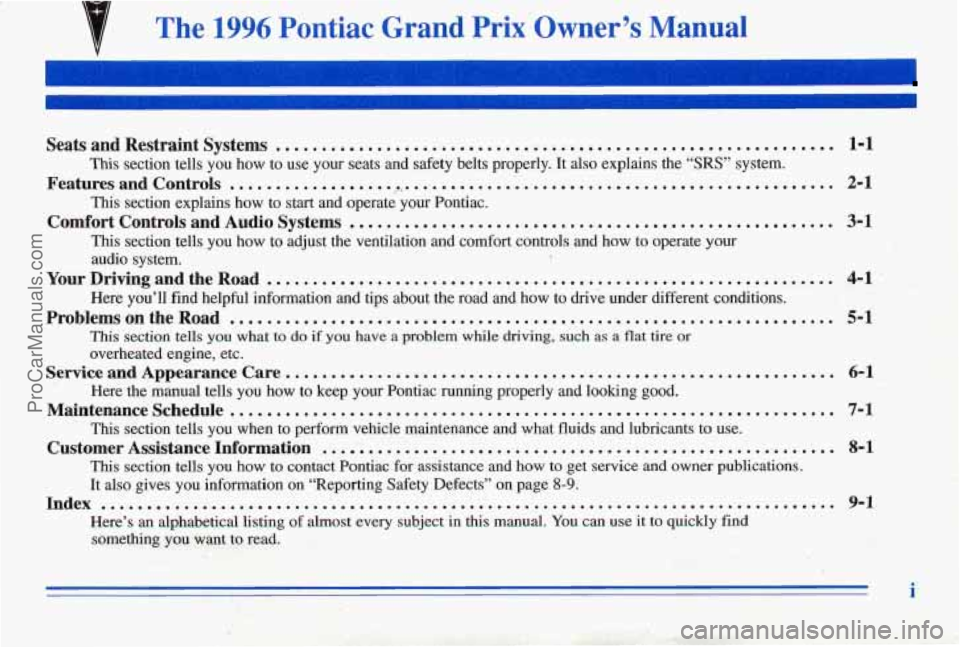
{ The 1996 Pontiac Grand Prix Owner’s Manual
SeatsandRestraintSystems ............................................................. 1-1
This section tells you how to use your seats and safety belts prop\
erly. It also explains the “SRS” system.
This section explains how to start and operate your Pontiac.
This section tells you how to adjust the ventilation and comfort co\
ntrols and how to operate your
audio system.
Here you’ll find helpful information and tips about the road\
and how to drive under different conditions.
This section tells you what to do if you have a problem while driving, such as a flat tire or
overheated engine, etc. Here the manual tells you how to keep your Pontiac running pr\
operly and looking good.
This section tells you when to perform vehicle maintenance and what \
fluids and lubricants to use.
This section tells you how to contact Pontiac for assistance and how to get service and owner pubiications.
It also gives you information on “Reporting Safety Defects”\
on page
8-9.
Here’s an alphabetical listing of almost every subject in this manual. You can use it to qbickly find
something you want to read.
Features and Controls ................................................................... 2-1
ComfortControlsandAudioSystems ..................................................... 3-1
YourDrivingandtheRoad .............................................................. 4-1
ProblemsontheRoad .................................................................. 5-1
Service and Appearance Care. ........................................................... 6-1
Maintenanceschedule .................................................................. 7-1
Customer Assistance Information ........................................................ 8-1
Index ........................................................................\
......... 9-1
i
ProCarManuals.com
Page 82 of 370
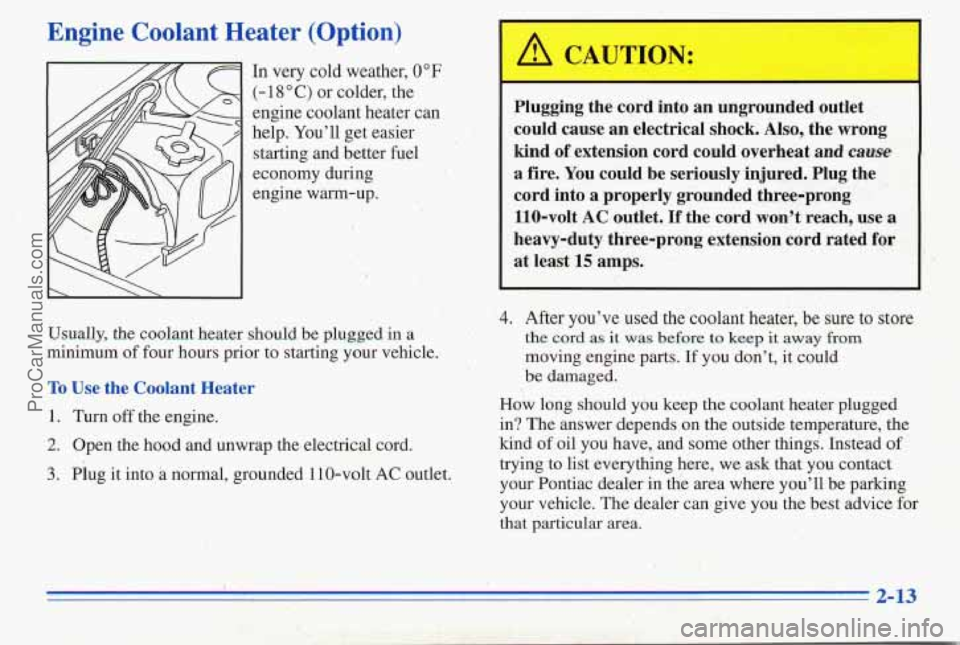
Engine Coolant Heater (Option)
In very cold weather, 0" F
(- 18 O C) or colder, the
engine coolant heater can
help. You'll get easier
starting and better fuel
economy during
engine warm-up.
A I
I A CAUTION: I
Plugging the cord into an ungrounded outlet
could cause an electrical shock. Also, the wrong
kind
of extension cord could overheat and cause
a fire. You could be seriously injured. Plug the
cord into a properly grounded three-prong 110-volt AC outlet.
If the cord won't reach, use a
heavy-duty three-prong extension cord rated for
I at least 15 amps.
4. After you've used the coolant heater, be sure to store
Usually, the coolant heater should be plugged in a the cord as it was before to keep it away from
minimum of four hours prior to starting your vehicle. moving engine parts. If you don't, it could
' - be damaged. To Use the- Coolant Heater
How long should you keep the coolant heater plugged
1. Turn off the engine.
in? The answer depends on the outside temperature, the
2. Open the hood and unwrap the electrical cord. kind of oil you have, and some other things. Instead of
.. - .. ' . ':. 1 :\'. . . .. .
~ ~
3. Plug it into a normal, grounded 110-volt AC outlet. trying to list
everything here, we ask that you contact
your Pontiac dealer in tlie area where you'll be parking
your vehicle. The dealer can give you-the best advice for
that particular area,
ProCarManuals.com
Page 86 of 370
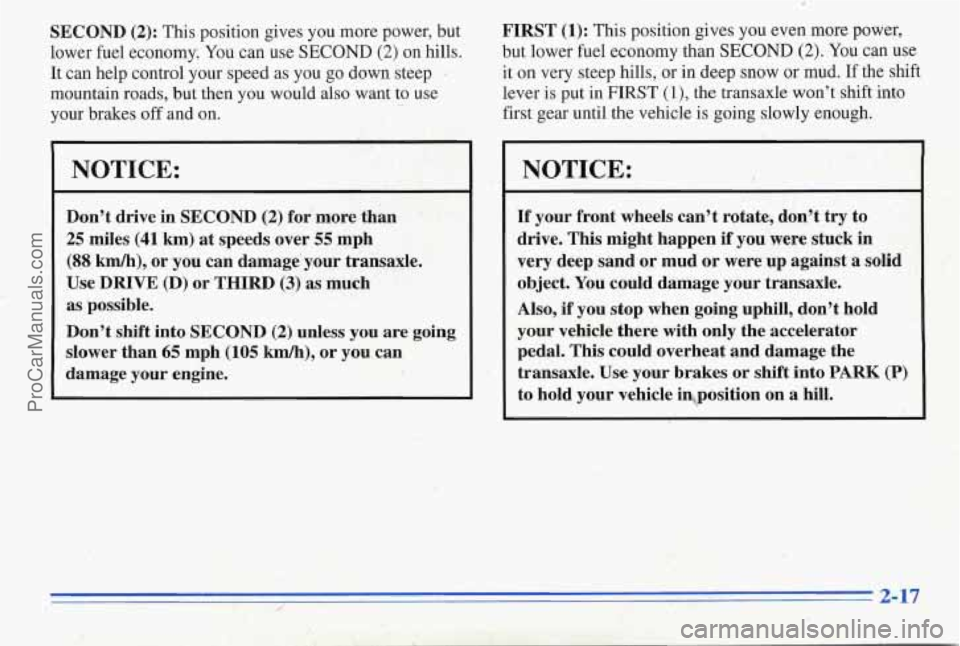
SECOND (2): This position gives you more power, but
lower fuel economy; You can use SECOND
(2) on hills.
It can help control your speed as you
go down steep .
mountain roads, but then you would also want to use
your brakes off and on.
-
NOTICE:
Don’t drive in SECOND (2) for more than
25 miles (41 km) at speeds over 55 mph
(88 km/h), or you can damage’ your transaxle.
Use
DRIVE (D) or THIRD (3) as much
as possible.
Don’t shift into SECOND
(2) unless you are going
slower than
65 mph (105 km/h), or you can
damage
your engine. FIRST
(1): This
position gives you even more power,
but lower fuel economy than SECOND
(2). You can use
it on very steep hills, or in deep snow or mud.
If the shift
lever is put in
FIRST (l), the transaxle won’t shift into
first gear until the vehicle
is going slowly enough.
~
If your front wheels can’t rotate, don’t try to
drive. This might happen
if you were stuck in
very deep sand or mud or were up against a solid
object. You could damage your transaxle.
Also,
if you stop when going uphill, don’t hold
your vehicle there with only the accelerator
pedal. This could overheat and damage the
transaxle. Use your brakes or shift
into PARK (P)
to hold your vehicle iqposition on a hill.
ProCarManuals.com
Page 88 of 370
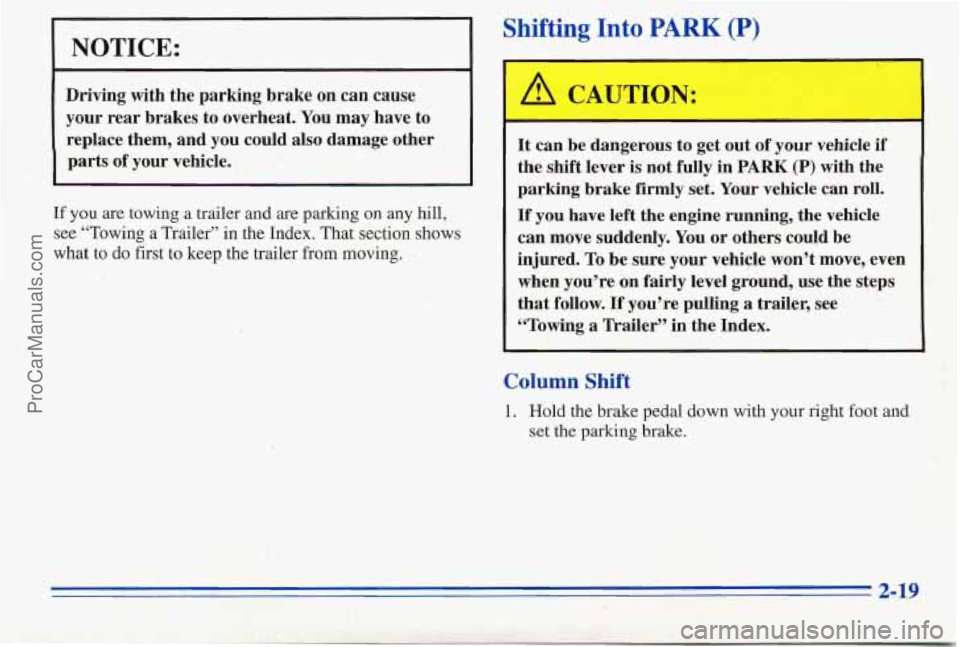
Shifting Into PARK (P)
NOTICE:
Driving with the parking brake on can cause
your rear brakes to overheat. You may have to
replace them, and you could also damage other
parts of your vehicle.
If
you are towing a trailer and are parking on any hill,
see "Towing a Trailer" in the Index. That section shows
what to do first
to keep the trailer from moving.
L
e dangerous to get out of your vehicle if
the shift. lever is not fully in
PARK (P) with the
parking brake firmly
set. Your vehicle can roll.
If you have left the engine running, the vehicle
can move suddenly.
You or others could be
injured.
TO be sure your vehicle won't move, even
when you're on
fairly level ground, use the steps
that follow.
If you're pulling a trailer, see
"Towing a Trailer'' in the Index.
Column Shift
1. Hold the brake pedal down with your right foot and
set the
parking brake.
ProCarManuals.com
Page 90 of 370
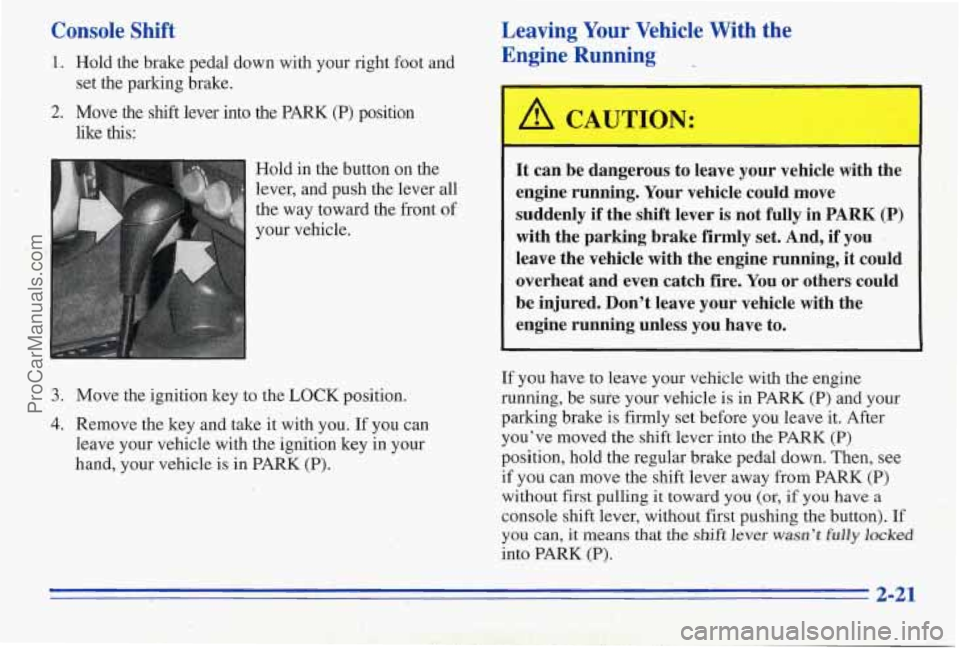
Console Shift
1. Hold the brake pedal down with your right foot and
2. Move the shift lever into the PARK (P) position
set the parking brake.
like
this:
I Hold in the button on the
lever,, and push ‘the lever
all
the way toward the front of
3. Move the ignition key to the ‘LOCK position.
4. Remove the key and take it with you. If you can
leave your vehicle with the ignition
key in your
hand, your vehicle is in PARK (P).
. /. 1 ,‘r ,*
Leaving Your Vehicle With the
Engine Running
A CAUTION:
It can be dangerous to leave your vehicle with the
engine running. Your vehicle could move
suddenly
if the shift lever is not fully in PARK (P)
with the parking brake firmly set. And, if you I
leave the vehicle with the engine running, it could
overheat and even catch fire. You or others could
be injured. Don’t leave your vehicle with the
engine running unless you have to.
If you have to leave your vehicle with the engine
running, be sure your vehicle is in PARK (P) and your
parking brake
is firmly set before you leave it. After
you’ve moved the shift lever into the PARK
(P)
position, hold the regular brake pedal down. Then, see
if you can move the shift lever away from PARK (P)
without
first pulling it toward you (or, if you have a
console shift lever, without first pushing the button). If
you can, it means that the shift lever wasn’t fully locked
into PARK (P) .
2-21
ProCarManuals.com
Page 119 of 370
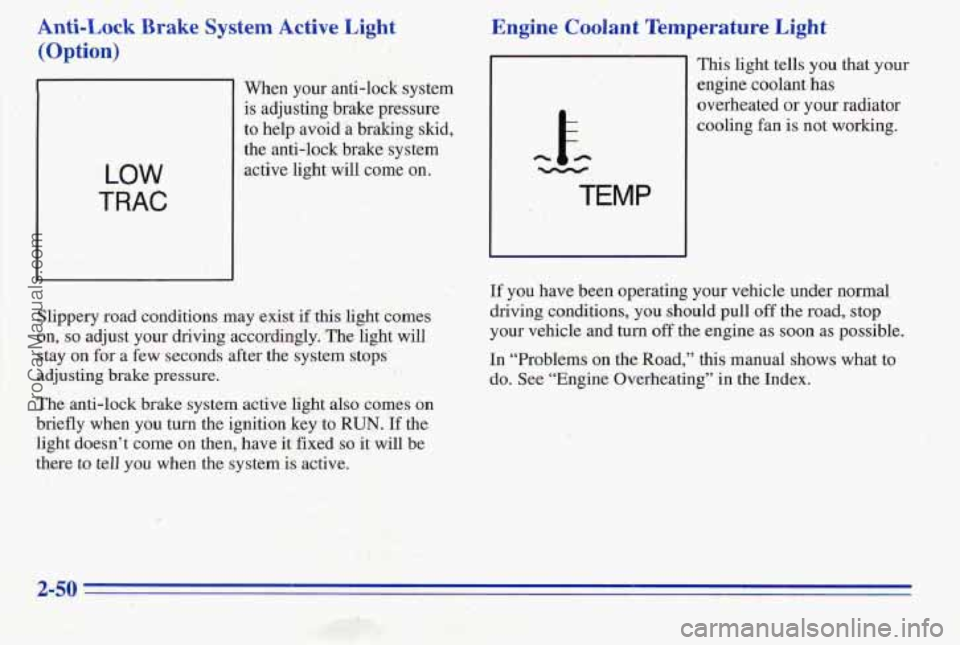
Anti-Lock Brake System Active Light
(Option)
Men your anti-lock system
is adjusting brake pressure
to help avoid a braking skid,
the anti-lock brake system
active light will come on.
Engine Coolant Temperature Light
h E- -
c. TEMP
This light tells you that your
engine coolant,
has
overheated or your radiator
c-ooling €an
is not working.
.. . ..
' .. 5
.. . .
Slippery road conditions may exist if this light comes
on,
so adjust your driving accordingly. The light will
stay un for a few seconds after the system stops
adjusting brake pressure.
If you have been operatmg your vehicle under normal
driving conditions, you should pull off the road, stop
your vehicle and turn off the engine as soon as possible.
In "Problems on the Road," this manual shows what to
do. See "Engine Overheating" in the Index.
The anti-lock brake system active light also come,s on
briefly when you turn the ignition key to RUN. If the
'light doesn't come on then, have it fixed
so it will be
there to tell you when the system is active.
ProCarManuals.com
Page 120 of 370
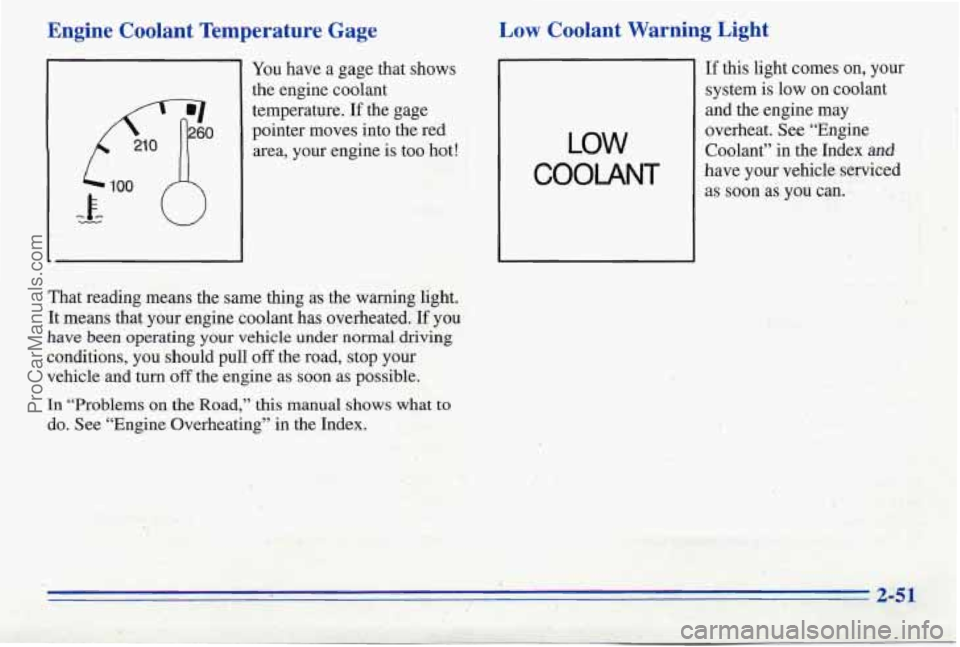
Engine Coolant Temperature Gage
You have a gage that shows
the engine coolant temperature.
If the gage
pointer moves into the red
area,
your engine is too hot!
Low Coolant Warning Light
LOW
COOLANT
If this light comes on, your
system
is low on coolant
and the engine may
overheat. See “Engine
Coolant” in the Index
and
have your vehicle serviced
as soon as you can.
That reading means the same thing as the warning light.
It means that your engine coolant has overheated.
If you
have been ‘operating your vehicle under normal driving
conditions, you should pull off the road, stop your
vehicle and turn
off the engine as soon as possible.
In “Problems on the Road,” this manual shows what to
do. S’ee “Engine Overheating” in the Index.
ProCarManuals.com
Page 191 of 370
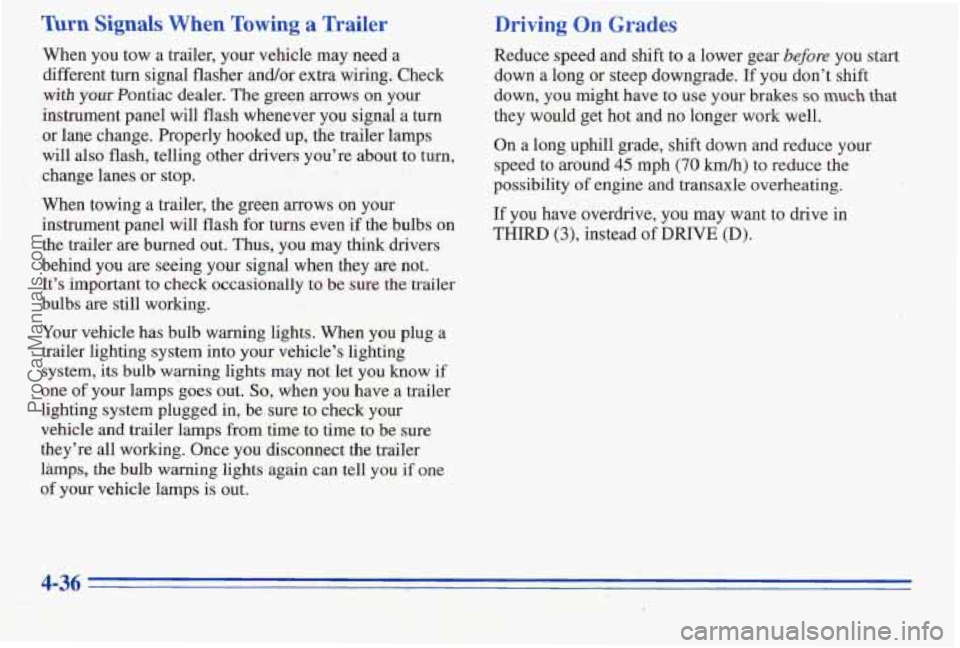
Turn Signals When Towing a Wailer
When you tow a trailer, your vehicle may need a
different turn signal flasher and/or extra wiring. Check
with your Pontiac dealer. The green arrows on your
instrument panel will
flash whenever you signal a turn
or lane change. Properly hooked up, the trailer lamps
will also flash, telling other drivers you’re about to
turn,
change lanes or stop.
When towing a trailer, the green arrows on your
instrument panel will, flash for turns even if the bulbs
on
the trailer are burned out. Thus, you may think drivers
behind you are seeing your signal when they are not.
It’s important to check occasionally
to be sure the trailer
bulbs are still working.
Your vehicle has bulb warning lights. When you plug a
trailer lighting system into your vehicle’s lighting
system, its bulb warning lights may not let you
know if
one
of your lamps goes out. So, when you have a trailer
lighting system plugged
in, be sure to check your
vehicle and trailer lamps from time to time to be
sure
they’re all working. Once you disconnect the trailer
lhmps,
the bulb warning lights again can tell you if one
of your vehicle lamps is out.
Driving On Grades
Reduce speed and shift to a lower gear before you start
down a long or steep downgrade. If you don’t shift
down, you might have to use your
brakes so much that
they wouJd get hot and no longer work well.
On a long uphill grade, shift down and reduce your
speed to around
45 mph (70 km/h) to reduce the
possibility
of engine and transaxle overheating.
If you have overdrive, you may want to drive in
THIRD (3), instead of DRIVE (D).
4-36
ProCarManuals.com